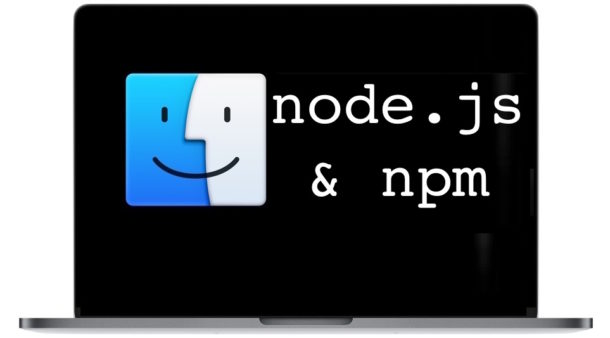
Npm Install For Mac
node.js allows you to run javascript in the Terminal as appose to a regular browser which makes for a modern workflow in web development, with both node.js installed and a package manager called npm (Node Package Manager) also installed, which can manage other packages that work with node.js, one of the main ones being gulp.jsfor a web development workflow.
To install node.js on macOS Mojave, Sierra (and earner OSX versions) you can download a pre-compiled binary package which makes a nice and easy installation. Head over to http://nodejs.org/ and click the install button to download the latest package. Either version is Ok, if you are new to it best to use the recommended version.
Npm versions. Npm is a separate project from Node.js, and tends to update more frequently. As a result, even if you’ve just downloaded Node.js (and therefore npm), you’ll probably need to update your npm. Luckily, npm knows how to update itself! To update your npm, type this into your terminal. When you install Node.js, you will find npm is installed as well, thus if you want npm you need to install NodeJS. There are several ways to install Node.js and NPM on the Mac, including using a prebuilt packaged installer, or by using Homebrew. This tutorial will cover both.
Install the package from the .dmg by following along the install wizard which will install both node and npm, npm is Node Package Manager which allows for installs of additional packages for node.js.
At the end of the install you are prompted to make sure that /usr/local/bin is in your path, double check you have it by running in the Terminal:
After install check it was ok by entering in the command line node which will open a node javascript session:
To exit the node.js session just hit ‘control’ + ‘c’ twice.
If you have an earlier version of node you can just download the latest version and install to upgrade it and it will over write the previous version.
To check your version of node run …
Installing Packages for Node
There are many packages for Node such as the popular gulp.js, you use the command npm to see a complete list run:
This will return an exhaustive list of available packages, to install a package run npm install
To list installed packages run
To upgrade minor versions of npm packages
To upgrade major versions of npm packages, run outpdated to see what needs upgrading
Install
Run it to give you a list
Then update the packages…
The package.json file will also update the version numbers
If you haven’t already installed the packages…
To sudo or not to sudo
It is cleaner not to use sudo when installing npm packages there are a couple of options here on how this is done.
Updating NodeJS
To upgrade node.js itself on macOS just download and install the latest from nodejs.org – this will simply override the previous version and keep all your packages that have been already installed.
npm is the world's largest Software Library (Registry) Ivms 4200 apk.
npm is also a software Package Manager and Installer
The World's Largest Software Registry (Library)
npm is the world's largest Software Registry.
The registry contains over 800,000 code packages.
Open-source developers use npm to share software.
Many organizations also use npm to manage private development.
Using npm is Free
npm is free to use.
You can download all npm public software packages without any registration or logon.
Command Line Client
npm includes a CLI (Command Line Client) that can be used to download and install software:
Windows Example
Mac OS Example
Installing npm
npm is installed with Node.js
This means that you have to install Node.js to get npm installed on your computer.
Download Node.js from the official Node.js web site: https://nodejs.org
Software Package Manager
The name npm (Node Package Manager) stems from when npm first was created as a package manager for Node.js.
All npm packages are defined in files called package.json.
The content of package.json must be written in JSON.
At least two fields must be present in the definition file: name and version.
Example
'name' : 'foo',
'version' : '1.2.3',
'description' : 'A package for fooing things',
'main' : 'foo.js',
'keywords' : ['foo', 'fool', 'foolish'],
'author' : 'John Doe',
'licence' : 'ISC'
}
Managing Dependencies
npm can manage dependencies.
npm can (in one command line) install all the dependencies of a project.
Dependencies are also defined in package.json.
Sharing Your Software
If you want to share your own software in the npm registry, you can sign in at:
Publishing a Package
You can publish any directory from your computer as long as the directory has a package.json file. Intermec pf8t driver for mac.
Check if npm is installed:
Check if you are logged in:
If not, log in:
Username: <your username>
Password: <your password>
Navigate to your project and publish your project:
C:Usersmyusermyproject>npm publish